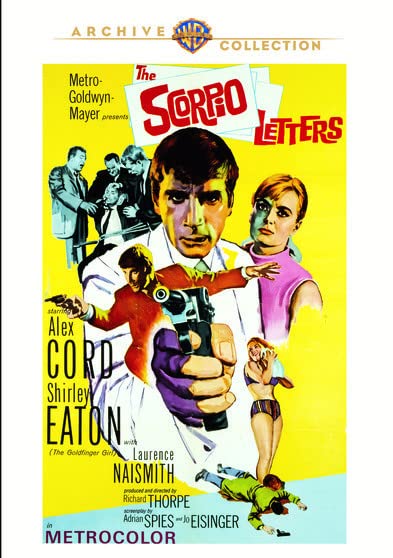
Quite often, all it takes in order to get the writing ball rolling is an idea. Just one single silly concept that can be molded and reshaped into something substantial. I know that all too well. Why, I can be standing in front of the mirror, brushing my teeth, and suddenly think of a (what I think is) great way to begin an article, and from the second I put it to virtual paper, it’s all downhill from there. Of course, there is that occasional motion picture offering that many people would probably prefer the sight of someone (not necessarily me, per se) brushing their teeth over. From the few people out there who have ever commented on the 1967 MGM feature The Scorpio Letters, I would include the bulk of them in that listing.
I can’t say their harsh judgment is justified, however, although I do agree with them that The Scorpio Letters is pretty bad. But in a good-bad kind of way. Sadly, there really isn’t a lot of information available on the rather obscure 1967 Eurospy film – and I wager many a Eurospy completist would totally argue with me that the movie even qualifies as an entry into the revered motion picture subgenre. Much like me finding unexpected inspiration from the sight of tiny bristles brushing up against frothy hard-to-reach incisors, all it took for screenwriter Adrien Spies (whose name was pronounced “spees”, sadly enough) to come up with his script was an idea. Fortunately for Mr. Spies, there was an entire continent full of ’em to steal from.
While based on a novel by Victor Canning, there is positively no denying the fact that The Scorpio Letters was just another attempt to mimic the various big-screen successes of the 007 film franchise. And, in their defense, everyone was doing just that at the time. Bond was a very hot cinematic commodity at that particular point in time – hotter than Auric Goldfinger’s favorite metal in molten form, even – so a (mostly tepid) assortment of ripoffs, knock-offs, and wannabes were rising to the top of the moviemaking melting pot much in the same way certain sexually transmitted parasites float to the top of jacuzzis at a swingers’ party. No one was immune to the fever. Even the suits at the major studio of MGM were keen to cash-in.
In fact, MGM even managed to get Goldfinger‘s most iconic victim, Shirley Eaton, to co-star in the film alongside American lead Alex Cord. Cord must have surely sensed his role as Joe Christopher – an American in the UK who does some occasional spy work just to stay in the black – wasn’t going to be a recurring part. (Joe Christopher isn’t the most marketable name, now is it?) So, the future Airwolf star – looking more like George Peppard than ever – alternates between hamming it up and not giving a rat’s ass as he bounces from one redressed set to another, squeezing in a trip to at least one or two actual exotic-looking (emphasis on “looking”) Southern California locales along the way as he attempts to unravel a blackmail ring in Europe.
Ms. Eaton co-stars as a fellow agent l’espionage who works for Cord’s employer’s British competition, who has better funding and more of a personality. Starting out with looking into the mysterious suicide of a British spy, undercover guy Joe Christopher soon finds himself infiltrating a legion of deadly hotel waiters (!) who are under the employ of the titular postal correspondence extortionist extraordinaire, “Scorpio” (as played by Oscar Beregi, Jr.) in France. Of course, the entire thing was filmed in and around the British and European-looking parts of the good ol’ classic MGM backlot at that. Laurence Naismith, Lester Matthews, Antoinette Bower, Arthur Malet, Émile Genest, and even Vincent Beck (the villain from Santa Claus Conquers the Martians!) co-star. Dave Grusin provides the less-than-memorable score.
Technically, The Scorpio Letters was little more than a television production. But the James Bond craze was so hot in Europe, this amusingly dumb and docile thriller was released theatrically over there, hopefully earning some of its (surely) low, low budget back in the process. The Warner Archive Collection presents the film in its matted widescreen production, which does not appear to have cropped out any vital information, indicating director Richard Thorpe (the same man who brought us Jailhouse Rock) had a bigger screen in mind when he made this, his second-to-last film. An open matte trailer for the feature accompanies in case anyone wishes to compare the two, though I think I like the colors of the trailer version better.
Snow-less ski lift that are, for some reason, in operation. A prop tea cup that pops up in both England and France (hey, maybe it was a really popular set!). New characters (including The Party‘s beautiful Danielle De Metz) that show up towards the finale. Editing that really makes you wonder if we have the US TV version over the extended European version. Yes, The Scorpio Letters fail to have any sort of sting whatsoever, but it’s exactly what the TV movie tries so hard to pass itself off as that makes it charming. Again, in a good-bad way, that is. It may be only slightly more entertaining than brushing one’s teeth to some, but I say give it a shot. Especially if you like (potentially unofficial) Eurospy films.
Plus, who can resist that International poster art? It makes Alex Cord look like John Cassavetes and Timothy Carey’s lovechild!
(Now there’s an idea I won’t dare go anywhere with.)